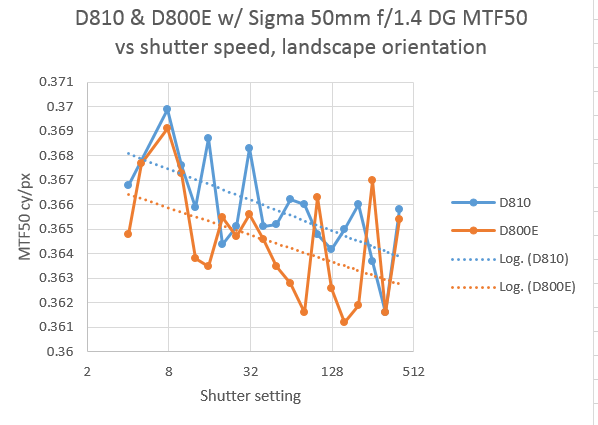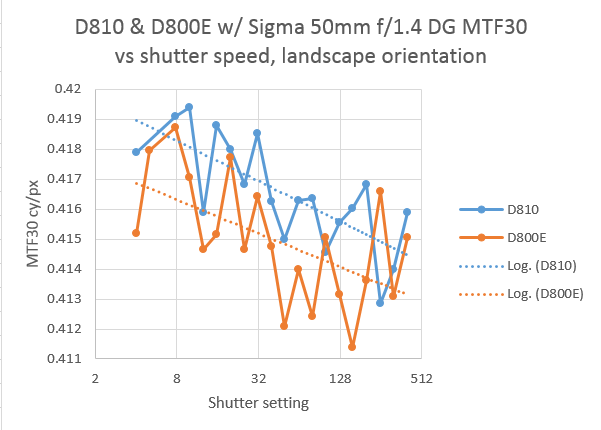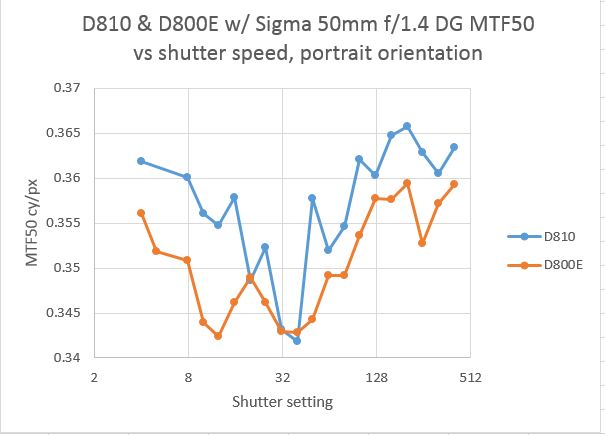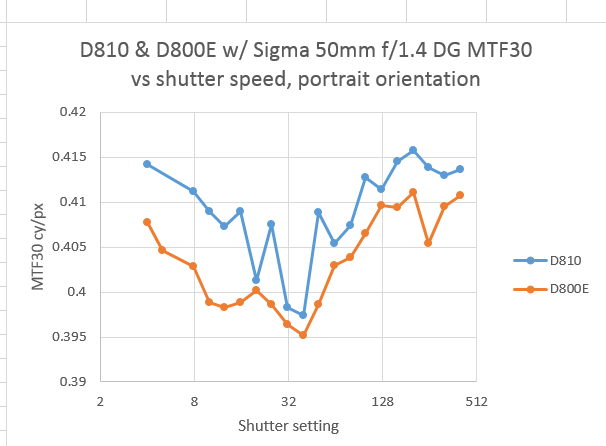There are rumors that the D810’s mirror and shutter motions are less damaging to image sharpness than those of the D800.
I thought it was worth running a test.
I put a Sigma 50mm f/1.4 DG on a D810, the camera in landscape orientation to an Arca Swiss Cube with a RRS L-bracket, and mounted the head to a sturdy set of RRS legs. Since the mirror and shutter in the D8x0 move up and down, and the tripod is stiffer in the vertical direction, the landscape orientation is the least vibration-prone way to orient the camera.
I aimed the camera at a slanted edge target illuminated with a Fotodiox 5500K LED flood. I set the self-timer to two seconds. I focused wide open, then set the aperture to f/5.6, the shutter speed to 1/400, the ISO to 100, and made an exposure. Then I turned down the flood (which doesn’t change color temperature as you reduce the light output) 1/3 of a stop, I made exposures with about the same mean sensor level in 1/3 stop intervals at shutter speeds down to 1/4 second.
Then I mounted a D800E and did the whole thing again.
I brought the raw files into Lightroom 5.6, set the white balance to Daylight, cropped to the target, and exported them as TIFF’s. I analysed the modulation transfer function (MTF) of all the images in Imatest using the horizontal edges.


There’s not much difference, but there’s a slight improvement with the D810. The vibration tends to increase with shutter speed. I fit logarithmic lines to the data so you can better judge that trend.
Mounting the cameras in portrait orientation and using the vertical edge give quite a different result:


The worst shutter speeds for both cameras are around 1/40 second, with the D810 again being slightly better. The difference between the two cameras is greater in this orientation, but in both cases the differences are small; this is not a reason to upgrade from a D800.
Steve in AZ says
If you tried less formidable — dare I say gold-plated — support, for example an air-travel tripod and mounted a long zoom on it, I believe you’d find a good deal more difference between the cameras. The difference might not have much practical consequence in that both images might be too degraded to use, but there should be a lot of difference in blur amplitude at the most impacted shutter speeds.
Jim says
Well, that’s refreshing! Usually people tell me that there’s no problem with their SoNiCanon A-744Q, that I’ve got if in for the manufacturer, and that all my vibration problems stem from not mounting the camera properly.
I’m sure you’re right. Longer lenses and Flexible-Flyer tripods will magnify any differences. OTOH, When the camera’s on a tripod, 95% of the time you’re going to use mirror lockup. And 99% of the time, if there’s EFCS, you’ll use that, too. Those things will make a much bigger difference than the difference between the two cameras when the mirrors are flapping.
Jim
Lynn Allan says
Thanks for providing this. I’m curious how a graph with A7r shutter shock values would super-impose on the D800 and D810 values.
And while I’m asking, do you have “shutter shock” values for the Canon 6d and/or 5d3 and/or 1Dx? If so, could they be super-imposed?